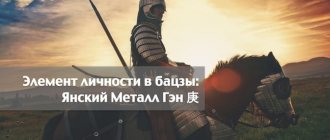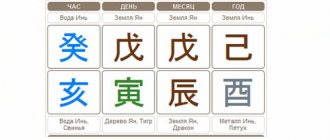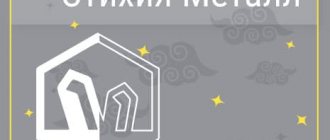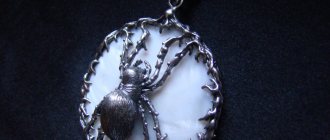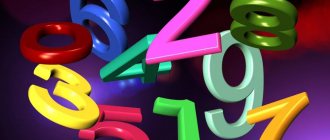In the Universe, everything that happens and exists explains the interaction of Yin-Yang, or trigram called Bagua. Chi energy is constantly moving. When it moves, it thereby contributes to the birth of Yang (activity), and when it enters calm, it becomes the source of Yin (passivity). The interaction of these two types of energy is the source of everything that exists in the world.
Both of the above energies are indicated by two lines. Yin is a broken line, while Yang is a continuous line. When each of them is separated, four types of energy are released. After this, the division occurs into 8 trigrams, where each component corresponds to the original energy (Yang or Yin).
Note! Each Bagua sector also has its own Gua number. It is different for each person, it can be calculated by year of birth.
How they are created
The Bagua trigrams together form an octagonal figure. It clearly describes all the processes and events taking place in the Universe and in our world. In fact, most feng shui teachings are based on this octagon.
By the way the lines are combined, you can find out what energy is transferred in it - movement or calm. If trigrams have identical types of the same polarity, they are designated as extreme Yin or Yang. Visually indicated, they look like one continuous or one interrupted line.
Note! Other combinations of the Bagua trigram denote one Yin or Yang line and 2 opposite ones. The essence of each is determined by a feature found in one copy - it is the leading one.
Other combinations of the trigram are made up of one “Yang” or “Yin” and the remaining two lines, which have the opposite direction. For example, if a population includes one solid "yang" trait and the others are "yin", it will be defined as belonging to yang.
Trigrams[edit]
八卦Bagua - eight trigrams (top bar - least significant binary digit)
| Trigram lines | 乾Qian ☰ 111 | 兌Duì ☱ 110 | 離Lī ☲ 101 | 震Zhen ☳ 100 | 巽Xun ☴ 011 | 坎Kǎn ☵ 010 | 艮GEN ☶ 001 | 坤Kun ☷ 000 |
| Nature | Heaven/Heaven 天Tiān | Lake/swamp 澤Zé | Heart of Fire 火Hu火 | Thunder 雷Lei | Wind 風Fēng | Water 水Shuǐ | Mount 山Shan | Earth 地Dì |
| Element and planet | Metallic/Neptune | Metallic/Venus | Fiery/Mars | Wooden / Jupiter | Wooden / Pluto | Watery/mercury | Earth/Uranus | Earthy / Saturn |
| Ba Xian | Han Xiang Zi | Zhongli Quan | Lu Dongbin | Cao Guojiu | He Xianggu | Lee Tieguay | Zhang Guolao | Lan Caihe |
| Personality | Philosophy | Saint Veselchak | Sovereignty | Emperor (General) | Tao Yin (Wise) | Pilgrim | Warrior hero | Feeling |
| Artifact | Flute | Hand fan | Sword | Castanets | Lotus | Hookah | Drum | A basket of flowers |
| Eight meridians [5] | Du Mai | Yin Wei Mai | Chong Mai | Yang Wei Mai | Yin Qiao Mai | Give Mai | Yang Qiao Mai | Ren Mai |
| Chinese dragon | Tianlong | Panlong, Feilong | Zhulong | Shenlong | Qinglong | Jiaolong, Dilong | Fuzanglong | Chilong |
| Acupuncture starting point | Hou Xi | Nei Guan | Gong Sun | Wai Guan | Zhao Hai | Zu Lin Qi | Shen Meng | Lie Que |
| Acupuncture channel | Xiao Chang | Xin Bao | Pi | San Jiao | Shen | Dan | Pan Guan | Fay |
| Chinese horoscope Equivalent to a Greek god | Sheep Apollo | Dog Aphrodite | Snake Demeter | Cat (pig) Hermes | Bird Athena | Rat Dionysus | Monkey Ares | Tiger Hera |
| Zan-fu | Hand | Tai Yin | Jue Yin | Yang Ming | Shao Yin | Shao Yang | Tai Yang | Pay |
| Baduanjin | 兩手托天理三焦 | 左右開弓似射雕 | 調理脾胃順單舉 | 攢拳怒目增氣力 | 兩手攀足固腎腰 | 搖頭擺尾去心火 | 五勞七傷向後瞧 | 背後七顛百病消 |
| Chakra | Sahasrara | Ajna | Anahata | Vishuddha | Svadhishthana | Manipura | Muladhara | Bindu |
| Axis points | Qianding | Yindan/Qiangjian | Danzhong/Shengdao | Tiantu/Yamen | Schenke/Mingmen | Zhongwan/Jinsuo | Shimen / Yaoyangquan | Huiyin |
| Mid-body acupuncture point | 百會 | 強間 | 膻中,神道 | 大椎廉泉 | 神闕,命門 | 脊中,中脘 | 腰陽關,氣海 | 華蓋,會陰 |
| Action | Think sound (to) | See | I love | Say | Feel | Make/have (Power) | Be | Exist |
| Bushido | Honesty | Respect | Bravery | Honor | Compassion | Honesty | Loyalty | Self-control |
| Equivalent to Greek titanium | Uranus (Father Sky) | Gemera (Day) | Ether (Fire) | Chaos (Storm, Chaotic) | Nyx (Tree) | Pontus (Sea) | Orea (Mountain) | Gaia (Mother Earth) |
| The human body | Spirit | Nervous system | The cardiovascular system | The immune system | Reproductive system | Skeletal system | Excretory system | Muscular system |
| Virtue and sin | Faith - Heresy | Renunciation - Envy | Chastity - Lust | Modest - vanity | Dedication - Lazy | Moderation - Greedy | Patience is anger | Charity - Materialist |
| 24 hours | 12 | 9 | 6 | 3 | 15 | 18 | 21 years old | 0 |
| 360 degrees | 180 | 135 | 90 | 45 | 225 | 270 | 315 | 0 |
| Cardinal direction (opposite Antarctica) | South North) | South-East (North-East) | East | Northeast (Southeast) | South-West (North-West) | West | North-West (South-West) | North South) |
| Energy | Solar | Wind | Thermal | Electric | Organic | Hydraulic | Fossil | Gravitational |
| Nature Event | Star strikes (Magnectic fields) Meteor comet | Hurricane | Forest fires | lightning storm | Plague disease | Tsunami Flood | Eruption | Earthquake |
| Image of trigram lines | Full, All (Force) | Bucket (Washing Machine, Cleaning) | Sphere (Cyclic) | Cup (drinker, taster) | Bridge (Helper) | Target (Danger) | Gate, Door (Guardian, Keeper, Key) | Empty, nothing (darkness) |
| Arctic season (opposite Antarctica) | Summer solstice June 21 | May 7 | Spring equinox March 21 | February 7 (Azure Dragon) | August 7 (Cinnabar) | Autumn equinox September 21 | October 7th | Winter Solstice December 21 (White Tiger) |
| Feng Shui Number (King Wen/Fu Xi) 5 Center | 6/9 | 7/4 | 9/3 | 3/2 | 4/8 | 1/7 | 2/6 | 8/1 |
| The human body | Head | Arm/Shoulder | Chest / Chest | Forearm/hand | Thigh/buttocks | Abdomen | Knee/foot | Uterus |
| Bone | Scull | Brachial bone | Rib cage | Radius/Ulna | Femur | Spinal cord | Tibia/Fibula | Pelvis |
| Endocrine glands | Pineal gland | Pituitary | Thymus | Thyroid | Ovary | Pancreas | Testicles | Adrenal glands |
What is their manifestation
What are Bagua trigrams? They represent eight different forms of manifestation of Qi - the energy of life. Through these phenomena, events taking place in the Universe are easily described. This explains the cause of natural phenomena, the existence of cardinal directions and body parts, the occurrence of cataclysms, and so on.
The meanings of each trigram are numerous. Below are some characteristics, but this is a very small part of the manifestation of energy that has enormous power.
- The Kan sign is the number 1 and the symbol of the abyss. Has a water element. Symbolizes attention, secrecy, judicious wisdom.
- The Kun sign has the number 2, the earth element and the southwest direction. Denotes gentleness, calmness, submission. Symbolizes the mother of the family.
- The Zhen complex has the number 3, the wood element, the eastern direction. Means assertiveness and aggression. Symbolizes the eldest of the sons. According to this trigram, in Feng Shui the room of the first-born son is placed in the eastern part.
- The Shun complex is the number 4, the southeast direction and the wood element. Indicates wind, speed, mobility. This trigram symbolizes the eldest daughter in the family. Their rooms are located in the southeastern part of the house.
- The Tian trigram has the element of metal and the number 6, symbolizing creation and authority. This set is identified with the father of the family or head. According to Feng Shui, the father's room should be in the northwestern part of the house.
- The Dui complex is the number 7 and a symbol of joy. It has a water element and a western direction. Displays joy and spontaneity.
- The set of Gen is the number 8 and the symbol of peace. It has the element of earth and northeast direction. Represents mountains and stubbornness.
- The Li sign is the number 9 and the meaning of affection, has a fire element. Indicates fire and attractiveness as well as greatness.
Characteristics of eight sides
- The side of the breath of life: in this side it is good to woo a bride, make a long journey, invite a lama teacher, call on a patron spirit. There is a ban on sacrifices to deities and raid hunting;
- Side of health and medicine: in this side it is good to invite a doctor, order medicine, perform a cleansing ritual, eat food;
- Side of wealth: in this side it is good to buy goods and livestock, sow grain, perform the ritual of increasing wealth;
- The side of the fire of life and the Horse of the Winds: in this side it is good to go on a journey, bring a bride to the house, burn incense, hang symbols of worship of deities (flags and scraps of material) in the wind;
- Side of Harm: In this side one should not take a bride, acquire or buy goods and livestock. Garbage is usually thrown in this direction;
- Side of the Five Barriers (demons): in this side, the ban on inviting a doctor and going on a long journey is observed; to protect against the dangers emanating from this side, the ritual of “correction” is performed;
- End of life side: in this side, the prohibition of doing things related to life and well-being is observed;
- The side of evil spirits: in this side, the ban on holding sports competitions and horse racing, on the purchase and acquisition of goods is observed, the ritual of cleansing from bad deeds and imposing a ban on them is performed.
How are they used in Feng Shui?
All trigrams are located in a circle; they have unique directions in relation to any side of the world. There are two known variations of their designation.
Bagua of the Early Sky, which demonstrates the pristine and ideal structure of the world. This diagram shows harmony and order. Extreme Yin here is located in the north, and Yang is in the south. This pattern of marking can be seen on the Bagua mirror - one of the most famous Feng Shui symbols. This type of designation shows an ideal model of the Universe that has reached absolute harmony.
Note! The diagram was compiled by Wu of Xia, who discovered a turtle with a Bagua square on its shell.
The second variety is the Later Sky Bagua, which began to be used in 1143 BC, being introduced into use by Wen Wang. Using such a trigram, it becomes possible to assess the energy of any home. To perform such a measurement, you need to go outside and take measurements using a compass, focusing on the front door. Having found out the location of your home relative to parts of the world, you should take its plan and divide it into nine identical squares. The resulting drawing is then combined with the Late Sky Bagua. This comparison will allow you to determine which trigram controls each part of the home. If some part is unfavorable according to Feng Shui, then the totality of the features of this sector of the home is problematic. This puts negative energy on its residents.
In practice, it is the Later Sky Bagua scheme that is used. This happens because the world is not constant and ideal. Perfection is not continuous, everything changes and develops.
Exposure to the Eight Bagua Elements on the Days of the Week
- The day under the influence of the FIRE element is favorable for blacksmithing, wearing jewelry, praying and visiting the temple, and performing virtues. Unfavorable for reconciliation, bringing a bride to the house, slaughtering livestock, conducting military operations and translating works from one language to another.
- The day of influence of the EARTH element is favorable for carrying out excavation and agricultural work, traveling in an easterly direction, renouncing an oath and getting rid of damage. Unfavorable for laying foundations, funerals, ablutions and performing prayers.
- The day under the influence of the METAL element is favorable for cutting wood, hunting and traveling in an easterly direction. Unfavorable for teaching a child to walk and sending him anywhere from home.
- The day of exposure to the SKY element is favorable for meetings with famous and influential people, performing virtues and the ritual of removing damage (gurum). Unfavorable for treating diseases, carrying out construction work, moving and trading.
- The day under the influence of the WATER element is favorable for performing prayers and sacrifices to the nagas, returning what was borrowed or for temporary use, and artistic metal processing. Unfavorable for crossing a river, spells of evil spirits of the area, fishing, taking an oath, earthworks and fighting enemies.
- The day of influence of the MOUNTAIN element is favorable for performing prayers and sacrifices, starting spiritual practice, training a horse, laying a foundation and carrying out construction work. Unfavorable for starting important and large affairs, trading and reading.
- The day under the influence of the TREE element is favorable for performing prayers and sacrifices, wearing jewelry, planting trees, determining a place to settle and laying the foundation for a house.
- The day of influence of the WIND element is favorable for pronouncing a mantra, repaying debts, in order to calm an angry person and for all “heavy” matters. Unfavorable for taking an oath and holding meetings.
May 6, 2021 at 1:20 p.m.
© Tanaka Eliza
Bagua-zhang. “Eight palms” or “Sixty-four fighting techniques for almost all hand-to-hand situations.
Good day, Soldiers! If we try to briefly characterize the Baguazhang style, we can say that it is a purely Taoist system of psychophysical development of the individual, which trains the brain very well and gives hand-to-hand combat skills.
In order to achieve such a “double effect”, a specific combat system was developed, completely tied to one of the principles of Eastern philosophy - the eight trigrams, as a result of which each “Basic Palm” fully corresponds to a trigram.
[ad#1]
And their constant transition from one to another symbolized the principle of these very changes, to which everything around is subject, that is, “Bagua”. And “Zhang” is “Palm”, symbolizing hand-to-hand combat.
Article navigation:1. A brief overview of the three internal fighting systems: taijiquan, xinyiquan and bagua zhang. 2. Bagua-zhang. The main technical feature. 3. Some interpretations of the “Basic Palms” of Baguazhang using the example of the first technical action. 4. Articles summary.
The reason for this not entirely standard solution to the problem of personality development is clear; you just need to remember the customs of the Middle Ages and slightly rework the phrase “And an immortal can die of hunger.” That is, the ancient masters, not being masterminds, understood perfectly well that self-development and other subtle matters at the first stage of personality development are SECONDARY things, and the primary thing was always the ability to SURVIVE!
In other words... You can reach a very high level of your own development, be dedicated to the nth level and have access to the corresponding secret circles, but be stupidly shortened on your head while walking, just because some brat from a lousy and forgotten aristocratic family urgently needed to test the sharpness of his sword on a certain smart guy who was not quite efficient in bending his body in a respectful bow.
A brief overview of the three internal fighting systems: taijiquan, xinyiquan and bagua zhang.
Hence, in order to manage everything, that is, to study self-defense and move towards some higher goals, systems of this kind were developed that make it possible to combine both self-defense and personal development.
Such systems were based on certain universal ethical and philosophical constructs, such as “Yin-Yang”, “Eight Trigrams”, as well as “Five Elements”, and it was on their basis that the three most famous styles in our time were developed: taijiquan, Xinyiquan and Bagua Zhang. True, there is also a fourth little-known style of liuhebafa-quan, which is discussed below.
Taijiquan. It is based on the “Yin-Yang” principle. The movements of the style are rounded. He specializes more in fighting at medium and short distances, which, in fact, is what all the techniques, for example, kicks, are designed for. The battle strategy is more defensive than offensive, and defense is often interpreted as preparation for an attack.
Xinyiquan. It is based on the principle of the “Five Elements”. The combat strategy is more active than passive. The emphasis is on straight forward and backward movements. Offensive movements are often used as defensive ones. Movements are mostly straightforward; sideways movements are quite rare. Low kicks, maximum groin level. The style is effective when fighting at medium distance.
Bagua-zhang. It is based on the principle of the “Eight Trigrams”. The movements and techniques of combat contain the image of a circle. Attack and defense are given equal importance. Usually, they work “from defense,” that is, first there is a rounded defensive movement, then a rounded attacking action. Effective at all three distances, as indicated by analysis of the technical arsenal. The kicks are mostly low.
The elements of Bagua Zhang are not from a demonstration film, but from a feature film, that is, you can see a more or less “live” work, which demonstrates both a solo training option and a fight “with the main bastard.” The selected fight consists of elements of the fighting style described here, almost one hundred percent, and after viewing this excerpt, you will form an idea of how this system looks externally and how the “palms” work in a fight, even if it is directed by stunt coordinators.
As we can see, “Yin-Yang”, “Five Elements” and “Eight Trigrams” are the basis of the three fighting styles. Accordingly, a not-so-wild idea appears that these styles are one system, only divided into three components. Hence, it is logical to assume that there must be a certain universal style that simultaneously includes all three postulates of Chinese philosophy, since these are inextricably linked with each other.
This assumption is correct, since there is also a little-known fourth style: Liuhebafa-quan. It is based on the principles of “Yin-Yang”, “Five Elements” and “Eight Trigrams”. The movements use both a straight line and a circle. The technical arsenal is designed for combat at all distances. The kicks are also low. It should be noted that there is both a synthetic style taught by those who are familiar with the previous three, and an original style that has not yet left China.
They are mainly of interest to those who are fascinated by “secret schools of combat,” since nothing is really known about lyuhebach and what he is is also not entirely clear. Hence the rumors and corresponding interest.
Among the Western population, the first three styles are especially popular and this happened for the reason that it is believed that only in them there are methods for developing internal energy, and since in the West self-development is mainly understood as the ability to feel internal energy, hence the corresponding interest.
It should be noted that other fighting styles are popular in Russia, as evidenced by word statistics from Yandex and Google: boxing, karate, muya thai, wing chun and a number of others, more applied, since tai chi, xin-i and bagua Zhang in applied terms are very weak, since in the twentieth century they developed exclusively as health-improving disciplines.
These three styles have several things in common. First, training and keeping your mind calm. Secondly, Taijiquan, Xinyiquan, Bagua Zhang have a very good healing effect, both physically and mentally, normalizing a number of parameters of the human body. Thirdly, these systems set as their goal the activation, development and ability to manage internal energy. Although, I repeat once again, attention is paid to the development of energy in many other fighting styles, especially if they were developed by Taoists.
Bagua-zhang. The main technical feature.
The Bagua Zhang system is characterized by several very interesting features:
1. All movements are basically round in shape.
2. The fight takes place while moving in a circle with the goal of being on the side of the enemy or behind his back.
3. In his arsenal he has sixty-four tactical combat techniques, each of which can be used in many situations.
4. These basic sixty-four tactics can be combined with each other in any order.
The third point is interesting for us, because if free combination of palms can still be mentioned in some books and videos dedicated to Bagua Zhang, then there is generally silence about multiple ways to use each palm. The maximum that can be is a few options for use and that’s it, that’s enough. And the reader or viewer usually believes that this action is “a little cooler than the others, since the others can be used in only one case each, and this is “in as many as three”!
Knowing the love of Asians for secrets, it is possible that they themselves “added the secret.” Often, even the Chinese, call this school “64 techniques of Bagua Zhang,” i.e. they themselves are no longer “aware” of the fact that each movement can be used in many different situations.
Hence, if a person studies Bagua Zhang, as they say, in practice, then he will be forced to hone these “palms” as specific actions against specific attacks, because this is how it is shown in books and videos, thus diligently turning into an excellent combat system into castrated garbage.
Hence, in order for the applied value of the system to be “at its best”, a person in his training must adhere to the following very important rule:
EACH “PALM” OF BAGUA-ZHANG HAS MANY USES!
And in this way it is related to the domestic development of CHOY, created back in the days of the USSR, despite the different approaches to solving the problem in creating a universal combat system.
Any “palm” can be used in a variety of situations, you just need to train in the appropriate way, and this is very simple to do. Before starting pair training, it is necessary to learn some basic movement and first develop it, which implies mental elaboration of those hypothetical situations when the movement can be successfully applied. Thus, we not only make our technique more universal and ourselves unpredictable for the enemy, but we will also fully load our own brain, as it will begin to SOLVE THE PROBLEM, and this is a key condition for its development. You can read more about how to develop your brain in the article “How to develop your brain by studying hand-to-hand combat. Part 1.
So, in order to actually turn Bagua Zhang into a real supersystem, it is necessary to apply the following approach. A person must first learn some tactical technique from the sixty-four. Then work through it carefully, mentally looking for ways to apply the learned action. And only then practice it in pairs, simulating various situations in which the learned combat technique will be most effective.
Pay attention to the main nuance of this work. The trainee does not practice the same situation over and over again - no. He concentrates on searching through all possible situations in which the tactical technique chosen for testing will be most effective. The goal of the trainee is to make each “palm” as universal as possible, to go through all possible situations, and since there are already 64 such actions, then, I believe, the combat power of Bagua Zhang has already begun to be truly realized, since, having found at least a hundred options application of each tactical combat technique, in total we get 6,400 options for their use, which covers many combat situations, thus leaving behind a large number of other combat systems!
If, in addition to this, Bagua Zhang is merged with the key knowledge of the principle of “Free Reaching” (link), the skill of circular movement is formed at least at a basic level (link), the sixty-four techniques themselves begin to be perceived as just variants of a universal combat complex, and also start working on vulnerable zones and points, the presence of which in Bagua Chang, practically nothing is said in our time, then the combat system will turn out to be extremely lethal, many times superior to, for example, the same Wing Chun, to which Nowadays there is clearly increased interest.
A small picture graphically depicting the above. “Personal motor sphere” is the basis. It is characterized by a conscious sense of personal distance, knowledge of its unique properties and a high level of coordination. “Sticking”, “rooting”, spontaneous defenses” and tui shou (pushing hands, although it would be more correct to call contact control) are the key skills of hand-to-hand combat in general, and not just Bagua Zhang. By uniting together (a sphere with key skills), we get a completely new quality, incommensurably more powerful than its components.
Well, of course, we remember that, just as children’s blocks can be stacked with each other in any order, so in the “Tactical techniques” of Bagua Zhang you need to learn how to move from action to action in any sequence. You just need to make sure that this happens quickly, smoothly and without loss of strength. But the development of these skills to the “skill” level is laid down at the basic level, since they are key. You can get acquainted with these skills in the article “Foundation Level. A quick start or keys to the art of combat" (link).
Some decoding of “Basic palms” using the example of the first technical action.
Ten transcripts of the first microcomplex from the “Bagua Zhang of the Floating Body” complex according to the book by Yang Junming: “Eme School of Bagua Zhang Theory and Practice.” You can download it at the end of the publication.
Palm 1. The golden needle is directed to the sky - the palm of the strike is up.
Execution. Stand straight, face forward, arms freely lowered. Make an arc with your left hand to the side and up, and then lower it to the level of the solar plexus, palm down. Before the arm completes this movement, the outstretched right arm is raised to chest level with the palm facing to the right.
Standard interpretation. Gray intercepts with his left forearm a blow from White's right hand. Gray then locks White's arm in place with his left hand while simultaneously stepping forward and jabbing forward into White's throat with his right hand.
Here are a few other ways to use this microset of movements. This becomes possible due to the fact that while maintaining the general structure of these movements, the nuances change, for example, changing the striking form, introducing grips, jewelry work of the torso, before-and-after actions with other limbs, lengthening working trajectories and many other factors.
1. With our right hand we intercept the enemy’s right hand, with which he strikes, and with a jerk we straighten it and (here the micro-complex begins), with our left hand we hit the area just above the elbow, trying to break it. Whether it worked out or not, it doesn’t matter - the situation in battle changes instantly - holding the enemy’s hand with the same hand and moving it down, we deliver a powerful direct blow with a vertical fist to the upper part of the body.
2. With our left hand we move our right hand away with the same movement, and with our second hand we do not strike, but with a forward movement we press down the opponent’s left hand, limiting its movement.
In order to see all the possibilities included in this set of movements, you need to look at them with an open mind and see the techniques as simply movements. Here, for example, is a direct poke to the throat with the palm looking to the side: this is a “forward” movement. A movement that can be used in many cases: these are strikes with various striking parts: palm, fist, leopard paw, fingers - one, several at once; these are “forward-on-the-go” throws, these are defensive actions by pressing the opponent’s limbs to his body; this is a threat with movement, when you stop an enemy flying at you by simulating a threatening movement in the area of his eyes; and much more…
3. The opponent strikes the face with either hand. You try to defend yourself with the first movement, but the enemy is already kicking from below. Continuing the previous movement, you use it to defend yourself, only from a kick. The second movement of the complex is action according to the situation.
4. The situation is almost the same: you “bought” some movement of the enemy, but he deceived you and delivers a powerful blow to the chest area, the way Kyokushin fighters like to do. You defend yourself with the same movement as in the third situation, moving his limb to the side as you go. The second is a strike with the fingers straight forward (remember that, according to the conditions of the microcomplex, the palm faces to the side).
The thing is that people are afraid to experiment, for fear of doing “wrong” and therefore they try to practice movements “millimeter by millimeter.” But this is complete nonsense, if only because it is impossible to do the same movements all the time, there will always be something wrong. In addition, a person begins to perceive simply variations of one movement as completely different, which leads to misunderstandings in the training process, when one coach says that everything is correct, and the other grabs his head from such a mockery of the canons of the school. It is here, when analyzing this Bagua Zhang microcomplex, that we work with movement options, so you shouldn’t be afraid of “wrongness.” As for “continuity” and “tradition,” you shouldn’t pay much attention to this: firstly, for a person, what is important first of all is the applied use of the techniques being studied, and secondly, no one will definitely pass on the tradition of the school through us .
5. Having used the first movement, we apply the second not to the throat, as recommended, but casually, past the head, grabbing the ear or temple.
6. With your first hand you deflected the enemy’s blow, took a step with your left foot forward and to the left, made a grab as written in paragraph 5 and, turning 180, threw the enemy.
7. The first movement was to grab the enemy’s hand and drag it down. We also use the second movement for grabbing: we grabbed the opponent’s hand, raised in defense, and also directed it down, thus fixing the hands, approximately the same way as Wing Chun fighters do. Further actions are possible with the feet or head.
8. Let’s say there is a boxing “deuce” against which “everyone is squealing.” Actions based on the same movements, only we interweave an additional movement, since there is no possibility of switching to another movement due to the high speed of the ligament: we defend ourselves with the first movement, withdrawing the left hand, and raising the forearm with the same hand (or with the same circular movement at the elbow), We protect ourselves from the second blow. Next, a direct movement with the right hand is carried out for the purpose of attack.
9. The opponent delivers a direct kick to the head area. We powerfully kick the leg in order to turn the enemy at least sideways, or better yet, with his back to himself. If the enemy turns out to be sideways, then if you do not know the combat points, you can strike him in the ear, which in itself is already very dangerous. If the back shows, a blow to the spine will be good.
10. Standard straight punch to the face. Actions: sharply falling down by tucking your legs under you, with your left hand we take the final position as a pre-emptive defense, with a direct blow of the fist with your right we give the enemy a “fly” in the groin area.
These are ten possible applications seen in this complex, “at a glance.”
You can, of course, give a transcript of all 64 movements, but this will be too huge a publication and it is unlikely that anyone will read it to the end. The main idea here is the idea that each movement is universal and can be used in many cases. Just like a hammer, which can be used to hammer nails, chop nuts, and use it as a small anvil, and as a means of self-defense... If a person works well at each of the sixty-four actions of Bagua Zhang, then there may be several times more options . The main thing here is not to get hung up on the endless repetition of the discovered options, but to constantly expand the scope of application of the “64 tactical techniques of Bagua Zhang” and then he will develop the skill of “achieving the goal”, when the body simply solves the task at hand “fully automatically”.
The articles are a short summary. 1. In Bagua Zhang there are eight “Basic Palms” with eight sub-palms, thus forming sixty-four tactical fighting techniques.
2. Each such tactical technique has many options for use.
3. Thus, each of the sixty-four fighting techniques of Bagua Zhang can be used in dozens of very different situations, that is, for carrying out fractures, counterattacks, tying the opponent’s hands, throwing him off balance, in throws and other situations.
4. From here, if you begin to practice Bagua Zhang fighting techniques in this version, then the versatility of the style and its combat potential will rise sharply, and the person himself will be able to very well raise the level of his training, since he will begin to practice the techniques in a more advanced version than the well-known method their developments and applications.
Dear readers of the blog “Master of Battle”! If you would like to subscribe to new articles, you can do so below:
Subscribe.
Map of the Yellow River[edit]
| Name | 節氣 Solar term | 屬性 Elements | Organs | Direction | Color | taste | 星相 Constellation | 體液 Body Liquid | Binary | 情志 Mood |
| Winter Solstice | 陽火(Fire) | 腎Kidneys | 北North | 丹red | 鹹Salty | 虛(Void/Aquarius) | 血Plasma | 011 | 恐 Fear | |
| The beginning of winter | 陰火(Fire) | 腸intestines | North-West | purple | 鹹Salty | 斗(Dipper/Sagittarius) | 血Plasma | 010 | 恐 Fear | |
| Autumn equinox | 陰水(Water) | 肝liver | West | 藍blue | 苦bitter | 房(Room/Scorpio) | 津Liquid | 110 | 憂 gloomy | |
| Beginning of autumn | 陽水(Water) | 膽gallbladder | 西南South-West | 黑black | 苦bitter | 角(Horn/Virgo) | 津Liquid | 111 | 憂 gloomy | |
| Summer Solstice | 陰木(Tree) | 肺lungs | 南South | blue | 辛Spicy | 星(Star/Leo) | 氣Air | 100 | 喜 joy | |
| Beginning of summer | 陽木(Tree) | 心Heart | 東南Southeast | 綠green | 辛Spicy | 井(Well/Gemini) | 氣Air | 101 | 喜 joy | |
| Spring equinox | 陽金(Metal) | 脾spleen | East | 黃yellow | 酸sour | 昴(Hairy Head/Taurus) | 精essence | 001 | 怒 anger | |
| The beginning of spring | 陰金(Metal) | 胃stomach | Northeast | White | 酸sour | 奎(Legs/Pisces) | 精essence | 000 | 怒 anger |
The element cycles in this diagram are: 生(Generation / Counterclockwise), 剋(Destructive / Clockwise)
火生水, 水生木, 木生金, 金生火火剋金, 金剋木, 木剋水, 水剋火
Fire brings water, water feeds wood, wood brings metal, metal brings fire.
Fire melts metal, metal chops wood, wood drains water, water extinguishes fire.
Land now appears on the Yellow River map.
King Wen "Late Sky" [edit]
King Wen Bagua arrangement "Later Heaven"
| Name | Nature | Season | 性情 personality | family | Direction | 意義 Meaning |
| Lee | 火 fire | In summer | clinging | 中女 Middle daughter | South | 麗Pulsating movement, radiance, luminaries. |
| Kun | 地 Earth | In summer | Susceptible | 母 Mother | 西南Southwest | 順Energy of perception, bestowing. |
| Blow | 澤 lake | Autumn | Glad | 少女 youngest daughter | West | 悅Joy, satisfaction, stagnation. |
| Qian | Heaven | Autumn | creative | 父 Father | 西北Northwest | 健Expansive energy, sky. |
| Kahn | water | Winter | Horrible | 中男 Middle son | North | 陷Danger, fast rivers, abyss, moon. |
| Gen | Mountain | Winter | Still | 少男 youngest son | Northeast | 止immobility, immobility. |
| Zhen | 雷 thunder | Spring | Exciting | 長男 Eldest son | East | 動Excitement, revolution, division. |
| Xun | 風 wind | Spring | Gentle | 長女 Eldest daughter | South East | 入Soft penetration, flexibility. |
Diagram of nine halls[edit]
| Name | 節氣 Solar term | 屬性 Elements | family | Direction | Color | Pulse | Binary | 四馬與治療法 Four Horses and Therapy |
| Winter Solstice | 太陽陽水(Water) | 父Father | 北North | 黑black | 沉deep | 111 | 11, 寒者熱之00 | |
| The beginning of winter | 太陽陰水(Water) | 長女 Eldest daughter | North-West | 藍blue | 沉deep | 110 | 11, 寒者熱之00 | |
| Autumn equinox | 少陽陽木(Tree) | 中男Middle Son | West | 綠green | 細Small | 101 | 10, 涼者溫之01 | |
| Beginning of autumn | 少陽陰木(Tree) | 少女 youngest daughter | 西南South-West | blue | 細Small | 100 | 10, 涼者溫之01 | |
| Summer Solstice | 太陰陰金(Metal) | 母 Mother | 南South | White | 浮Float | 000 | 00, 熱者寒之11 | |
| Beginning of summer | 太陰陽金(Metal) | 長男 Eldest son | 東南Southeast | 黃yellow | 浮Float | 001 | 00, 熱者寒之11 | |
| Spring equinox | 少陰陰火(Fire) | 中女 Middle daughter | East | purple | Big | 010 | 01少陰,溫者涼之10 | |
| The beginning of spring | 少陰陽火(Fire) | 少男 youngest son | Northeast | 丹red | Big | 011 | 01少陰,溫者涼之10 |
The element cycles in this diagram are: 生(Generation / Counterclockwise), 剋(Destructive / Clockwise)
水生木,木生金,金生火,生水火 水剋火,火剋金,金剋木,木剋水
Water feeds wood, wood brings metal, metal brings fire, fire brings water.
Water extinguishes fire, fire melts metal, metal cuts wood, wood drains water
The earth now competes in the elements. Wood, Fire, Metal and Water is a competition.



